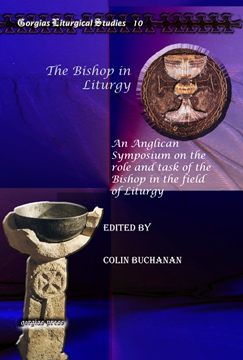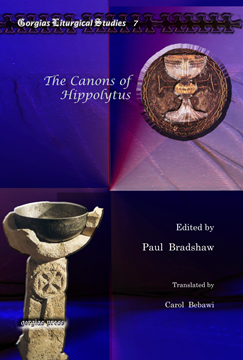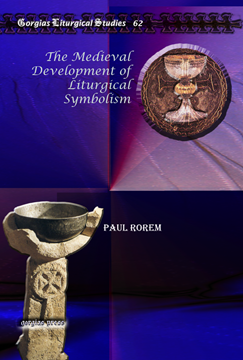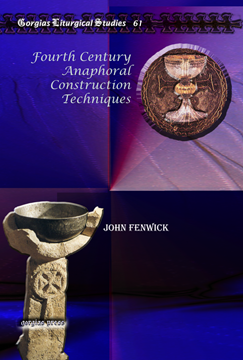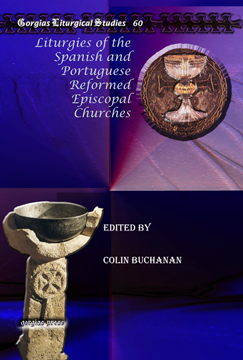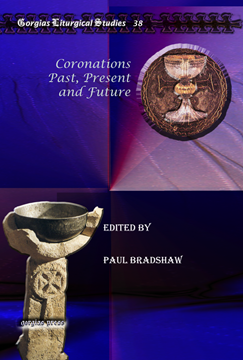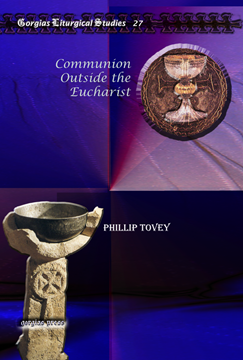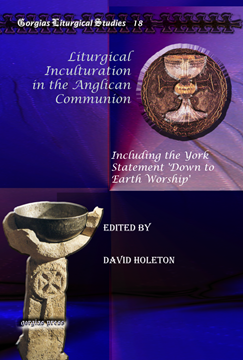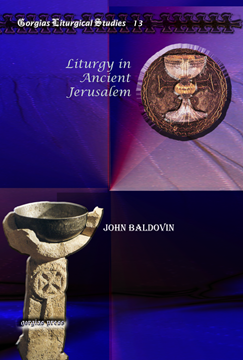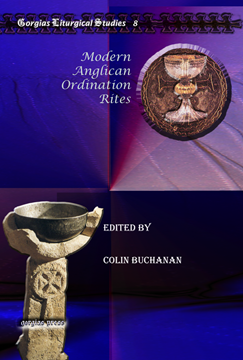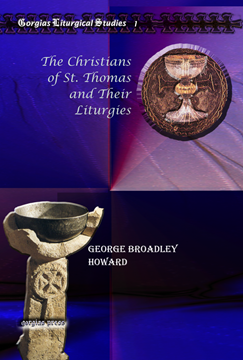Kiraz Liturgical Studies
This series provides a venue for studies about liturgies as well as books containing various liturgies. Making liturgical studies available to those who wish to learn more about their own worship and practice or about the traditions of other religious groups, this series includes works on service music, the daily offices, services for special occasions, and the sacraments.
The Bishop in Liturgy
An Anglican Symposium on the role and task of the Bishop in the field of Liturgy
Edited by Colin Buchanan
Series: Kiraz Liturgical Studies 10
ISBN: 978-1-60724-361-8
A series of essays exploring the sacerdotal role of the bishop in the Anglican church. Both historical and contemporary perspectives on the bishop's liturgical role are presented.
$138.00 (USD) $82.80 (USD)
A Kingdom of Priests
Liturgical Formation of the People of God
Edited by Talley Thomas
Series: Kiraz Liturgical Studies 9
ISBN: 978-1-60724-360-1
Papers read at the Anglican Liturgical Consultation Brixen, North Italy, 24-25 August 1987.
$138.00 (USD) $82.80 (USD)
The Canons of Hippolytus
Edited by Paul Bradshaw; Translated by Carol Bebawi
Series: Kiraz Liturgical Studies 7
ISBN: 978-1-60724-347-2
The fifth or sixth century document known as the 'Canons of Hippolytus' is a set of thirty-eight canons with a concluding sermon. They are presented here translated into English with an introduction.
$138.00 (USD) $82.80 (USD)
The Medieval Development of Liturgical Symbolism
By Paul Rorem
Series: Kiraz Liturgical Studies 62
ISBN: 978-1-60724-355-7
Liturgical allegory has often flourished in the history of Christianity, despite persistent pruning by sceptical theologians through the ages. The full fruits of this growth ripened during the Middle Ages, as preserved in the pages of Latin and Byzantine liturgical commentaries.
$138.00 (USD) $82.80 (USD)
Fourth Century Anaphoral Construction Techniques
By John Fenwick
Series: Kiraz Liturgical Studies 61
ISBN: 978-1-60724-353-3
The origins, methodologies, and uses of the Anaphoras of Sts. Basil and James are explored, along with examples.
$138.00 (USD) $82.80 (USD)
Liturgies of the Spanish and Portuguese Reformed Episcopal Churches
Edited by Colin Buchanan
Series: Kiraz Liturgical Studies 60
ISBN: 978-1-60724-352-6
The liturgies of the Spanish Reformed Episcopal Church and the Lusitanian Church are presented here and introduced by a bishop of the Anglican communion.
$138.00 (USD) $82.80 (USD)
Hippolytus: A Text for Students
Series: Kiraz Liturgical Studies 58
ISBN: 978-1-60724-350-2
This volume includes an introduction, translation, commentary, and notes.
$138.00 (USD) $82.80 (USD)
Language, Liturgy and Meaning
Series: Kiraz Liturgical Studies 57
ISBN: 978-1-60724-349-6
An intellectual exploration of language and liturgy and how both of them participate in the articulation of meaning.
$110.00 (USD) $66.00 (USD)
Liturgical Revision in the Church of England 1984-2004
The working of the Liturgical Commission
Series: Kiraz Liturgical Studies 55
ISBN: 978-1-60724-406-6
The liturgy of the Church of England is primarily located in The Book of Common Prayer (1662), but from the mid-20th century it has been enriched and supplemented by a range of authorized alternative services. Most of these were initially collected in The Alternative Service Book 1980 (ASB). From 1986 to 2005 there was a comprehensive revision and enlargement in the scope of alternative services. These, combined with the main elements of the 1662 tradition, are now published in Common Worship. The planning, drafting and processing of this work lay with the Liturgical Commission of the Church of England, and JLS 57 charts the separate but interlocking processes which this involved from the perspective of the Commission's Secretary and chronicler throughout the period 1984-2002.
$138.00 (USD) $82.80 (USD)
Infant Communion
The New Testament to the Reformation
By Mark Dalby
Series: Kiraz Liturgical Studies 54
ISBN: 978-1-60724-405-9
The communion of infants is different from the admission of children at, say, seven or eight. Both practices traditionally require baptism, and either may require confimation/chrysmation as well. But infant communion never requires a measure of 'understanding', whereas child communion does. As yet there is no comprehensive history of infant communion. Several learned attempts were made during the seventeenth and eighteenth centuries, but there were major gaps in their treatment and much that today needs amending. Thanks to the work of JDC Fisher and DR Holeton, many of these gaps have now been filled. I have drawn significantly on their work, as well as on an article of my own in CQR in 1966, but I have also sought to fill in more of the gaps.
$138.00 (USD) $82.80 (USD)
Mar Nestorius and Mar Theodore The Interpreter
The Forgotten Eucharistic Prayers of East Syria
Translated and Annotated by Bryan Spinks
Series: Kiraz Liturgical Studies 44
ISBN: 978-1-60724-395-3
This is a brilliant addition to the comprehensive range of patristic liturgical materials offered by this Series.
$138.00 (USD) $82.80 (USD)
Coronations Past, Present and Future
Edited by Paul Bradshaw
Series: Kiraz Liturgical Studies 38
ISBN: 978-1-60724-389-2
Henry Everett, Paul Bradshaw and Colin Buchanan combine to provide a post-Reformation overview of the changes and tendencies in the English Coronation service, including an astringent look at the likely future needs.
$138.00 (USD) $82.80 (USD)
Daily Prayer in the Reformed Tradition
An Initial Survey
Series: Kiraz Liturgical Studies 35
ISBN: 978-1-60724-386-1
Brings together two seminal articles from Studia Liturgica by the author with other evidence from disparate sources, and provides a powerful monograph about an area little studied by most scholars.
$138.00 (USD) $82.80 (USD)
Liturgy in Early Christian Egypt
Series: Kiraz Liturgical Studies 33
ISBN: 978-1-60724-384-7
Christian initiation, eucharistic liturgy and anaphora, orders, hours, and the liturgical year of the early Christian church in Egypt are the subject of this booklet.
$110.00 (USD) $66.00 (USD)
Ancient and Modern
Series: Kiraz Liturgical Studies 30
ISBN: 978-1-60724-381-6
An artful examination of the baptismal font and its place in ancient and modern Christianity. The basic concepts of water and baptism are also explored.
$139.00 (USD) $83.40 (USD)
Communion Outside the Eucharist
Series: Kiraz Liturgical Studies 27
ISBN: 978-1-60724-378-6
A study of Extended Communion, Sunday Worship in the Absent of a Priest, and similar services. This looks at the development of the services and their use in a variety of churches. Texts are also provided from some of the authorised services.
$138.00 (USD) $82.80 (USD)
Liturgical Presidency
By Paul James
Series: Kiraz Liturgical Studies 25
ISBN: 978-1-60724-376-2
The deliberate use of the title 'President' for the celebrant of the eucharist in the modern language rites of the Church of England demonstrates a change in understanding of not only the role of the priest/bishop, but of the whole people of God in the liturgical assembly.
$138.00 (USD) $82.80 (USD)
Irenaeus of Lyons on Baptism and Eucharist
Translated and Annotated by David Power
Series: Kiraz Liturgical Studies 21
ISBN: 978-1-60724-372-4
Selected texts with Introduction, Translation and Annotation.
$110.00 (USD) $66.00 (USD)
Liturgical Inculturation in the Anglican Communion
Including the York Statement 'Down to Earth Worship'
Edited by David Holeton
Series: Kiraz Liturgical Studies 18
ISBN: 978-1-60724-369-4
A set of essays exploring the concept of inculturation in the liturgy within the wide net of the Anglican world. Consideration of African and Asian liturgies are especially prominent.
$138.00 (USD) $82.80 (USD)
Liturgy in Ancient Jerusalem
Series: Kiraz Liturgical Studies 13
ISBN: 978-1-60724-364-9
This brief study investigates the liturgy of Jerusalem, a church which had a far-reaching and permanent effect on the rest of Christianity; initiation, the Eucharist, the Daily Office and the liturgical year are considered.
$110.00 (USD) $66.00 (USD)
Modern Anglican Ordination Rites
Edited by Colin Buchanan
Series: Kiraz Liturgical Studies 8
ISBN: 978-1-60724-359-5
This study presents the Anglican ordination rites from the 1970s and 1980s, analyzing and comparing their respective contents and character.
$100.00 (USD) $60.00 (USD)
From Jewish to Christian
Series: Kiraz Liturgical Studies 6
ISBN: 978-1-60724-346-5
An examination of the centres, patterns and elements of Jewish worship and the transition from Jewish worship to Christian. The study also considers the origin of several aspects of Christian worship.
$138.00 (USD) $82.80 (USD)
The Christians of St. Thomas and Their Liturgies
Series: Kiraz Liturgical Studies 1
ISBN: 978-1-59333-800-8
Originally written to inspire sympathy for their Eastern Christian compatriots among the membership of the Church of England, Howard’s study has become a touchstone for those seeking a sense of antique Christian liturgical practice. After providing a history of the “St. Thomas Christians,” the Orthodox Christians of India, up until the mid-nineteenth century, Howard presents English translations of six different anaphorae in use in Christendom: namely, those of St. James, St. Peter, The Twelve Apostles, Mar Dionysius Barsalibi, Mar Xystus, and Mar Evannis.
$171.00 (USD) $102.60 (USD)
Ambrosianum Mysterium
The Church of Milan and its liturgical tradtion
By Cesare Alzati; Translated by George Guiver & C.R.
Series: Kiraz Liturgical Studies 43
ISBN: 978-1-60724-394-6
The author is the Milanese expert on the Ambrosian rite and this (with Volume 2) makes available in English very important material previously unknown.
$138.00 (USD) $82.80 (USD)
Baptism in Early Byzantine Palestine 325-451
By Juliette Day
Series: Kiraz Liturgical Studies 42
ISBN: 978-1-60724-393-9
Juliette Day read a fascinating paper on this subject at the SLS Conference in 1998, and has now turned it into a published Study. It is distinguished by her great care about issues of both topography and dating in relation to Palestine, and in the process she both corrects other scholars and gives a notable overview of a special period.
$138.00 (USD) $82.80 (USD)

